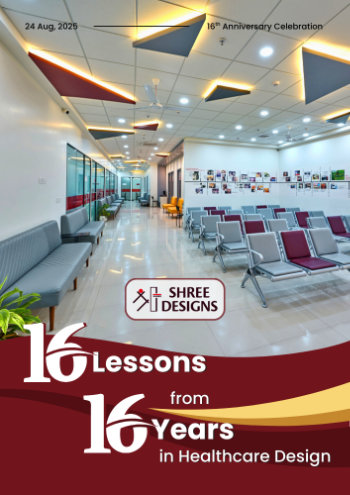Browse our short knowledge articles that help you create healthcare spaces that heal better, last longer, and work smarter.
Filter by media type to find exactly what you need.
Designing for Gen Z Patients
“They’re not used to waiting.”
“They want privacy—but not isolation.”
“They expect seamless digital journeys.”
That’s what we’re hearing in hospital boardrooms. And it points to one thing: Gen Z patients are reshaping healthcare design expectations.
At Shree Designs, we’ve identified 5 design shifts that future-ready hospitals, clinics, and diagnostic hubs must embrace:
1️⃣ Seamless digital–physical integration (check-ins, tele-consult pods)
2️⃣ Visual privacy, not isolation
3️⃣ Calm, sensory-friendly spaces for mental well-being
4️⃣ Inclusive and identity-affirming spaces
5️⃣ Waiting zones that feel like lounges, not queues
Healthcare is no longer just about clinical excellence—it’s about experience, trust, and accessibility.
👉 Read the full article here: https://www.linkedin.com/pulse/designing-gen-z-patients-what-healthcare-facilities-need-v1jsf
Can a commercial building truly function as a hospital?
A few years ago, we were asked to convert a corporate office into a fully functional hospital within six months.
The Challenge?
Low floor-to-ceiling heights, narrow lift shafts, no medical gas provisions - and yet, the client needed OT complexes, ICUs, and patient wards that met NABH standards.
With rising land costs and tighter project timelines, many healthcare providers are converting existing commercial structures into medical facilities. But the transformation isn’t as simple as adding partitions and medical equipment.
It demands careful planning to ensure:
🔹 Seamless patient flow and emergency access
🔹 Structural, MEP, and HVAC upgrades for clinical safety
🔹 Compliance with NABH and NBC healthcare norms
🔹 Future flexibility for medical technology and expansion
Can we bridge the gap between commercial architecture and clinical precision?
This article by Kshititi Nagarkar, Lead Architect, Shree Designs explores "Transforming Commercial Spaces into State-of-the-Art Hospitals"
Designing Dedicated Staff Zones That Work
Healthcare isn’t just patient-centred - it’s staff-supported.
Doctors, nurses, and admin teams work long shifts, juggle emergencies, and need spaces that restore focus and energy. Yet in many hospitals, staff zones are afterthoughts - cramped, noisy, or repurposed from leftover space.
Well-designed staff areas improve:
✅ Team communication
✅ Staff well-being and retention
✅ Response time in clinical zones
In this post, we share how to plan dedicated, efficient, and adaptable staff zones that support care from the inside out.
Why matte finishes are preferred in healthcare interiors
Shiny surfaces may look luxurious - but in healthcare, they can do more harm than good.
Matte finishes are not just an aesthetic choice; they’re a safety and functionality decision.
They reduce glare, hide smudges, and create a calmer visual environment for patients and staff alike.
From walls to floors to countertops, every surface tells a story - and in healthcare, that story is about hygiene, comfort, and focus.
In our latest post, we break down why matte wins in hospitals and clinics.
The Science of Hospital Windows
Good hospital windows do three things at once: save energy, protect patients, and connect people to natural light.
The right glazing, placement, and detailing can:
🌤️ improve patient recovery and mood
💨 enhance ventilation and infection control
🔥 reduce cooling loads and glare
🔇 block noise without blocking natural light
In this post, we unpack the science behind hospital windows — how light, air, and design come together to create safer, healthier healing spaces. - https://www.shreedesigns.in/shw


